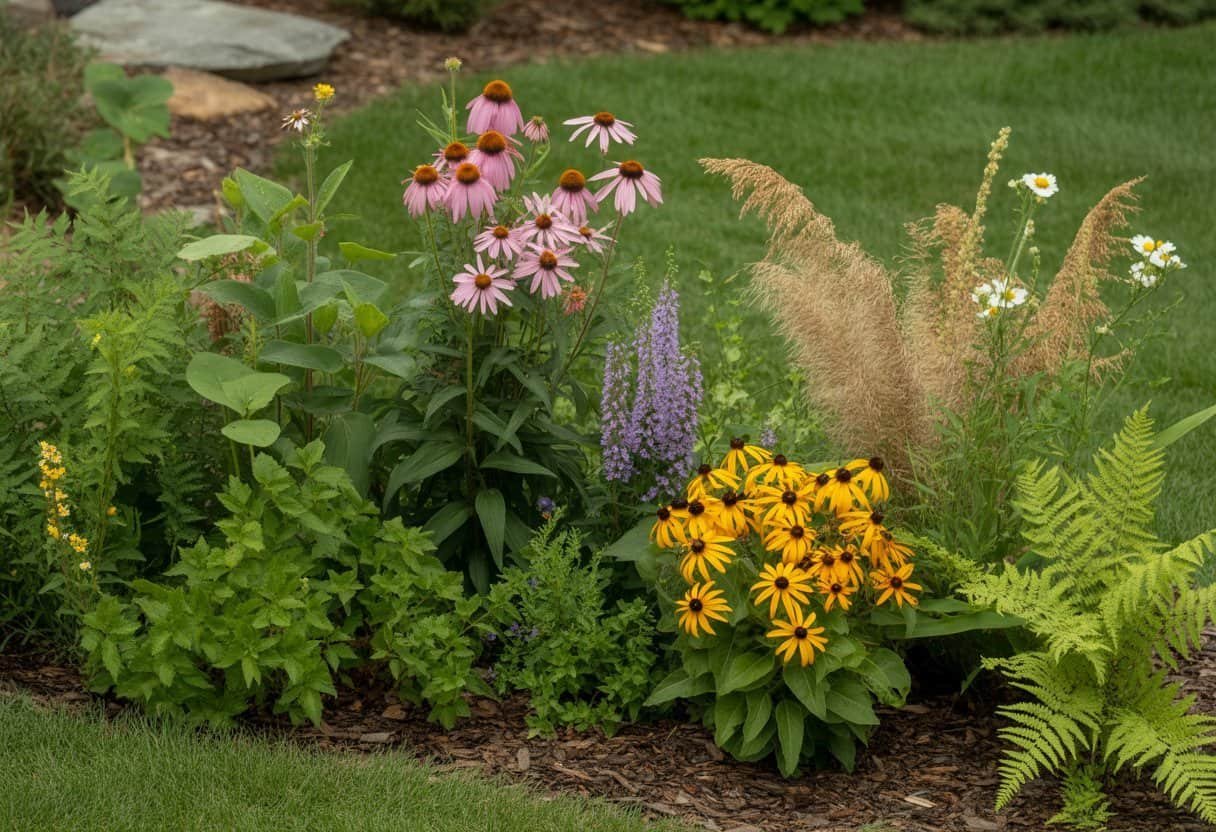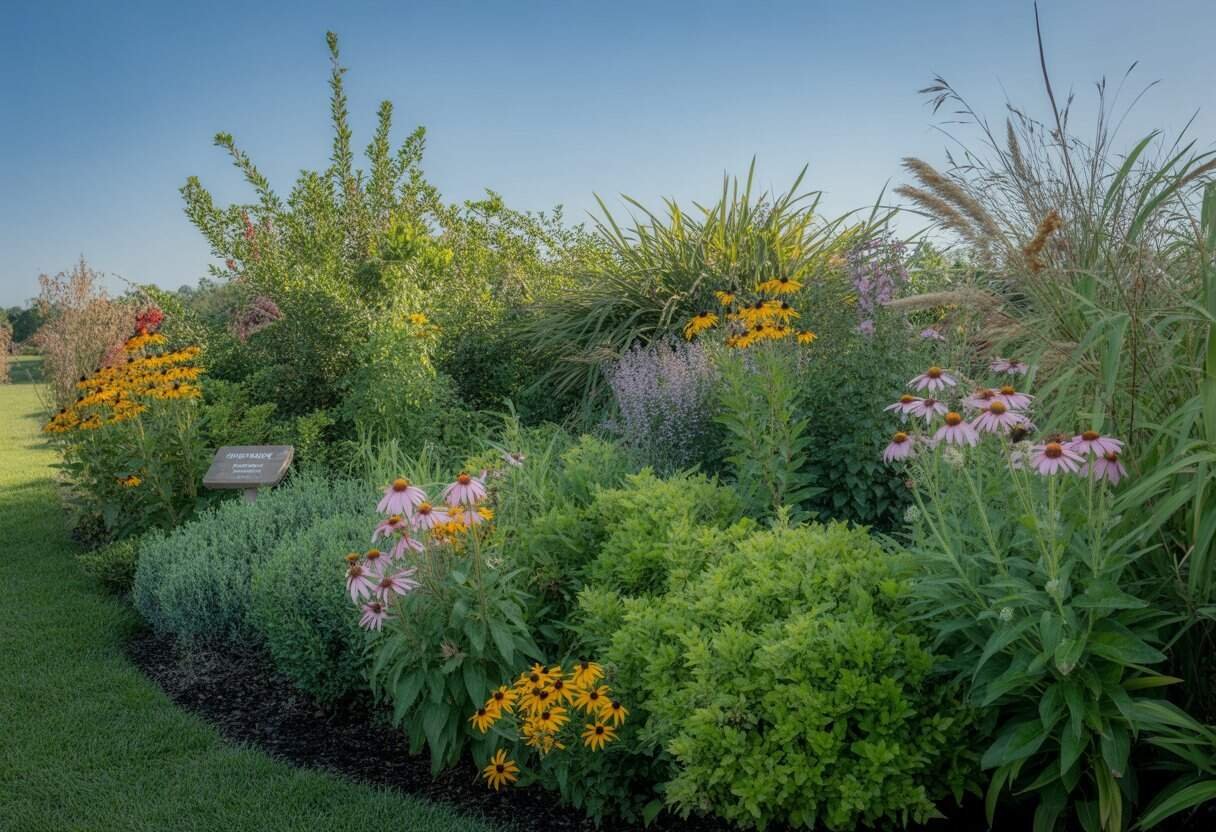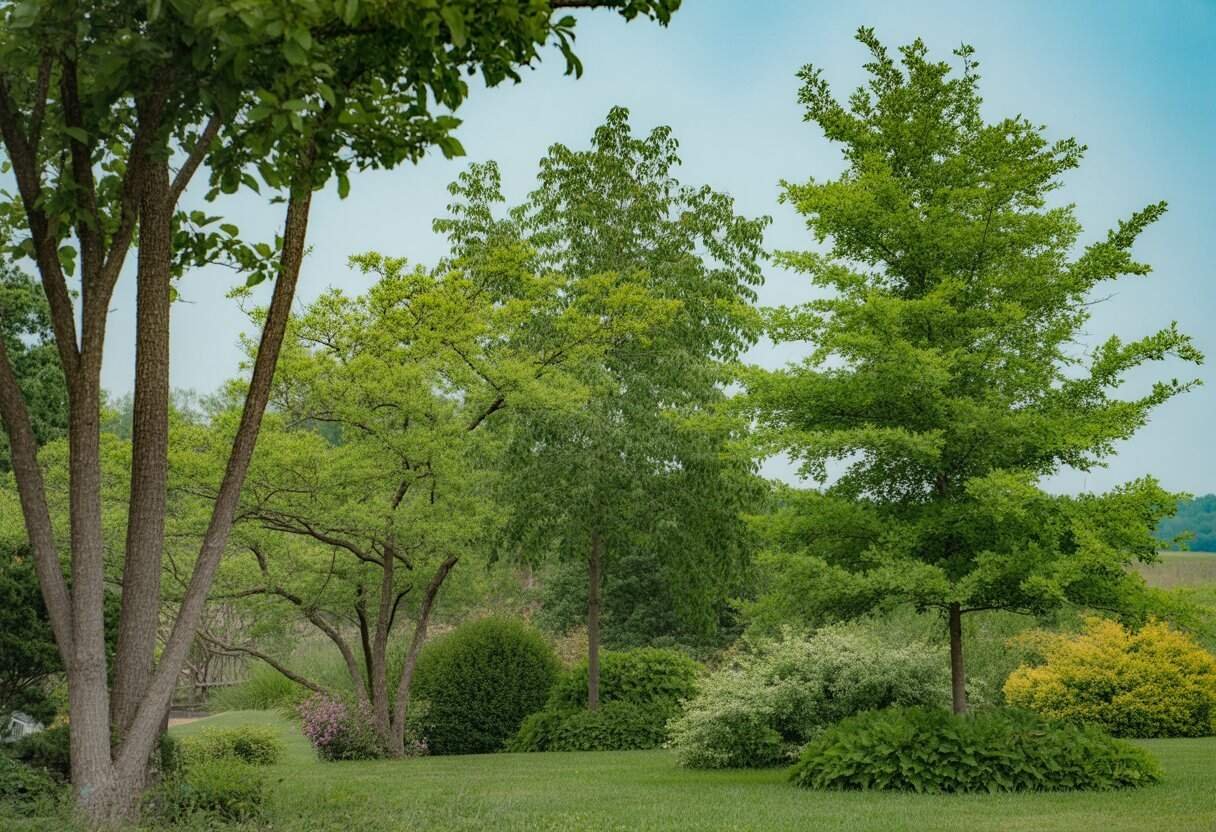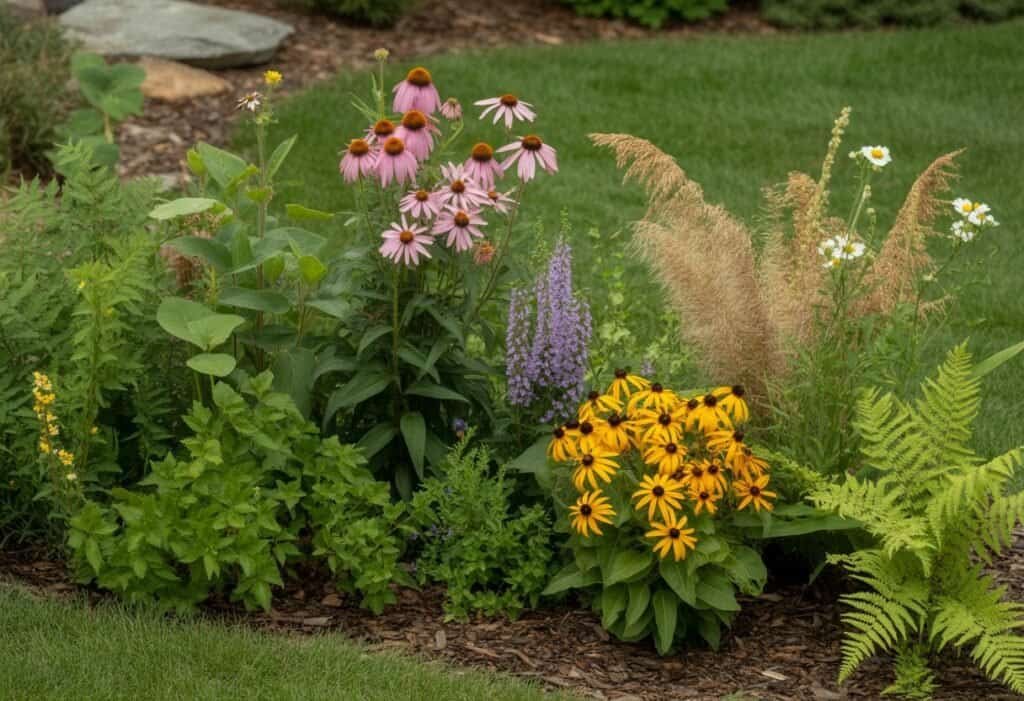Looking to enhance your Virginia garden with beautiful, low-maintenance plants? Virginia native plants offer an ideal solution for homeowners who want stunning landscapes that thrive in local conditions.
These indigenous species flourish in Virginia’s climate and soil, needing less water, fertilizer, and care than non-native alternatives.

Native plants support local wildlife, including birds, butterflies, and beneficial insects. From the vibrant colors of cardinal flower and black-eyed Susan to the height of oak trees and the delicate Virginia bluebells, Virginia offers a wide variety of native plants for every landscape need.
By adding Virginia natives to your yard, you create a more sustainable environment and connect with the region’s natural heritage. These plants have supported local ecosystems for thousands of years.
Key Takeaways
- Virginia native plants need less maintenance and resources and provide habitat for local wildlife.
- Choose native plants based on your site’s sunlight, soil type, and moisture levels.
- Creating a native plant landscape helps preserve Virginia’s natural heritage and reduces environmental impact.
Benefits of Landscaping with Virginia Native Plants
Virginia native plants offer practical advantages for homeowners and support local ecosystems. These plants have adapted to the region’s climate and soil over thousands of years.
Wildlife Habitat and Biodiversity
Native plants provide essential food and shelter for wildlife. Many Virginia butterflies and caterpillars depend on specific native plants.
For example, monarch butterflies rely on milkweed, and eastern tiger swallowtails need cherry and tulip trees. Birds also benefit from native landscaping.
Virginia’s native oak trees support over 500 species of caterpillars, which serve as crucial food for nesting birds and their young. Native berries from plants like serviceberry and dogwood provide nutrition during migration and winter.
Small mammals, beneficial insects, and pollinators thrive when native plants are present. A yard with diverse Virginia natives can support many more bird and butterfly species than one filled with non-native plants.
Conservation and Restoration
Using native plants helps preserve Virginia’s natural heritage. Many native species face declining populations due to development and habitat loss.
Including these plants in home landscapes creates corridors that connect natural areas. Native plantings protect local genetic diversity.
Regional ecotypes adapt to local conditions and maintain the character of Virginia’s ecosystems. Restoration projects succeed more often when they use native plants.
These plants help reduce erosion, filter pollutants, and restore damaged ecosystems. Native plants require fewer resources once established.
Low Maintenance and Sustainability
Virginia native plants need minimal care after they become established. Their deep roots help them survive drought without extra watering.
This saves time and lowers water bills. Native plants rarely need fertilizers or pesticides.
They have natural resistance to local pests and diseases, which reduces chemical use and saves money. Maintenance tasks like mowing and pruning decrease with native plantings.
Many native species grow to appropriate sizes for residential landscapes. Energy costs can drop when native trees and shrubs provide summer shade and let in winter sunlight.
Selecting Virginia Native Plants for Your Landscape

Virginia native plants support wildlife and need less maintenance once established. Choosing the right plants depends on understanding your site conditions and using available resources.
Understanding Habitat Conditions
Before choosing native plants, assess your landscape’s conditions. Check how much sunlight your yard receives.
Is it full sun (6+ hours), partial sun (4-6 hours), or shade (less than 4 hours)? Test your soil type and pH.
Virginia has soils ranging from clay to sandy loam. Most garden centers sell affordable soil test kits.
Observe how water collects or drains after rain. Some areas might stay wet while others dry quickly.
Consider your property’s slopes or flat areas. Plants for slopes differ from those for flat spots.
If deer often visit, choose deer-resistant native species like American beautyberry or switchgrass.
Using Native Plant Finder Tools
The Digital Atlas of Virginia Flora (vaplantatlas.org) provides a database of Virginia native plants. You can search by county, habitat, or plant traits.
The Native Plant Finder from the National Wildlife Federation (nwf.org/nativeplantfinder) ranks plants by their value to butterflies and moths. Virginia Cooperative Extension offers plant lists for different regions and growing conditions.
Local native plant societies hold plant sales where experts give advice. Virginia Native Plant Society chapters organize these events regularly.
Mobile apps like iNaturalist help identify existing plants in your area.
Choosing Native Alternatives
| Popular Non-Native | Virginia Native Alternative | Benefits |
|---|---|---|
| Bradford Pear | Serviceberry (Amelanchier spp.) | Beautiful spring flowers, edible berries, fall color |
| English Ivy | Virginia Creeper (Parthenocissus quinquefolia) | Striking fall color, bird-friendly berries |
| Japanese Barberry | Virginia Sweetspire (Itea virginica) | Fragrant flowers, stunning fall foliage |
| Burning Bush | Virginia Sumac (Rhus spp.) | Brilliant red fall color, wildlife value |
| Privet Hedge | Northern Bayberry (Morella pensylvanica) | Evergreen, aromatic, bird-friendly |
Native alternatives usually need less water and maintenance. They have evolved to thrive in local conditions.
Many native plants offer interest through flowers, berries, and fall color.
Advice for Homeowners
Start with a few native species instead of changing your whole landscape at once. A native plant bed or border is a manageable first project.
Group plants with similar water and light needs together to create planting zones. This practice, called hydrozoning, reduces maintenance and improves plant health.
Be patient with new plantings. Many native perennials follow the saying: “First year they sleep, second year they creep, third year they leap.”
Join local gardening groups focused on native plants. These communities offer knowledge, plant swaps, and support.
Keep plant tags and make a simple map of your plantings for reference. This helps you track what works in different areas of your yard.
Native Trees for Virginia Landscapes

Virginia’s native trees provide beauty, shade, and habitat for wildlife. They adapt to local soil and climate, making them low-maintenance choices for sustainable landscaping.
White Oak and Red Oak
White Oak (Quercus alba) is one of Virginia’s most majestic native trees. It grows slowly, reaching 80-100 feet tall with a wide spread.
The tree has lobed leaves that turn burgundy-red in fall. White Oaks can live for centuries and support over 500 species of caterpillars.
Red Oak (Quercus rubra) grows faster than White Oak and reaches similar heights. Its pointed-lobe leaves turn brilliant red in fall.
Both oaks produce acorns that feed wildlife such as deer, squirrels, and turkeys. These trees thrive in full sun to partial shade and adapt to many soil types.
They develop deep taproots and become drought-resistant once established. Plant them where they have space to grow.
American Sycamore and Black Gum
American Sycamore (Platanus occidentalis) stands out with its mottled, exfoliating bark. These fast-growing trees thrive in moist areas and can reach 75-100 feet tall.
Their large trunks and wide canopies provide excellent shade. Sycamores produce round, spiky seed balls that feed birds in winter.
They grow best near water but adapt to average landscape conditions. Black Gum (Nyssa sylvatica), also called Tupelo, shows brilliant scarlet fall color.
These medium-sized trees (30-50 feet) have a pyramidal shape when young. Their small blue-black fruits attract birds and wildlife.
Black Gums tolerate wet soils but adapt to drier sites once established. They have few pest problems and work well as specimen trees.
Sweetbay Magnolia and American Holly
Sweetbay Magnolia (Magnolia virginiana) adds elegance to Virginia landscapes. This smaller tree (15-30 feet) has creamy white, lemon-scented flowers in late spring and summer.
Its semi-evergreen leaves have silvery undersides that shimmer in the breeze. Sweetbay thrives in moist, acidic soils and partial shade.
It fits well in woodland gardens or as a patio tree. American Holly (Ilex opaca) provides year-round interest with glossy evergreen leaves and bright red berries.
These slow-growing trees reach 15-30 feet tall. Plant both male and female holly trees for berry production.
Berries appear on female trees after pollination. American Holly tolerates shade and prefers well-drained, acidic soil.
Birds enjoy the berries, and the dense foliage gives nesting habitat and winter protection.
Outstanding Native Shrubs and Small Trees
Virginia gardens benefit from native shrubs and small trees that offer year-round interest and support wildlife. These plants need less maintenance and water once established.
Red Chokeberry and Aronia
Red Chokeberry (Aronia arbutifolia) is a versatile Virginia native shrub. It grows 6-10 feet tall and 3-5 feet wide, fitting borders or as a specimen plant.
In spring, white to pale pink flowers attract pollinators. Summer brings glossy green leaves that turn red and purple in fall.
Bright red berries last through winter, feeding birds when food is scarce. Red Chokeberry adapts to various soils, including wet spots.
It thrives in full sun to partial shade and needs little pruning.
Wildlife benefits:
- Flowers support native bees and butterflies
- Berries feed over 20 bird species
- Dense growth provides nesting habitat
Winterberry and Ilex
Winterberry (Ilex verticillata) adds winter color to Virginia landscapes. This deciduous holly drops its leaves in fall, revealing bright red berries.
Winterberry grows in wet soils and reaches 6-10 feet tall. Plant both male and female shrubs for berries.
One male can pollinate up to ten females. Winterberry prefers acidic soil and full sun for best berry production.
Planting tips:
- Choose cultivars like ‘Winter Red’ for lots of fruit
- Plant in groups for impact
- Use in rain gardens or poorly drained areas
- Combine with evergreens for winter contrast
Smooth Hydrangea and Hydrangea
Smooth Hydrangea (Hydrangea arborescens) offers impressive summer blooms in shady Virginia gardens. This native shrub produces large, rounded flower clusters that start green and mature to white.
Unlike non-native hydrangeas, Smooth Hydrangea thrives in woodland conditions. It grows 3-5 feet tall and spreads by suckers to form colonies.
The most popular cultivar, ‘Annabelle,’ features massive blooms up to 12 inches across. Smooth Hydrangea blooms on new wood, so winter damage doesn’t affect flowering.
Cut stems back in late winter for stronger stems and larger flowers. This adaptable shrub tolerates clay soil and drought once established.
The dried flower heads provide winter interest and seeds for birds.
Virginia Sweetspire and Itea
Virginia Sweetspire (Itea virginica) offers multi-season appeal for Virginia gardens. This spreading shrub grows 3-5 feet tall with arching branches.
In late spring, fragrant white flower spikes cascade like small waterfalls and attract pollinators. The summer foliage is dark green and glossy, turning orange, red, and purple in fall.
This fall color often persists into December. Virginia Sweetspire grows well in both wet and dry locations once established.
It spreads slowly through suckers to form colonies. This makes it excellent for stabilizing slopes or naturalizing areas.
Recommended cultivars:
- ‘Henry’s Garnet’ – intense burgundy fall color
- ‘Little Henry’ – compact form for smaller gardens
- ‘Merlot’ – deeper wine-red autumn foliage
Perennial Flowers and Pollinator Favorites
Virginia’s native perennial flowers offer beautiful, low-maintenance options that support local pollinators. These plants create stunning landscape displays that return year after year.
Purple Coneflower and Black-Eyed Susan
Purple Coneflower (Echinacea purpurea) stands out with its purple-pink petals and raised center cone. This drought-tolerant perennial blooms from June through September and grows 2-5 feet tall in full to partial sun.
Black-Eyed Susan (Rudbeckia fulgida) features bright yellow petals with dark brown centers. These flowers bloom from June to October, reaching 2-3 feet in height.
Both plants attract butterflies, bees, and birds—especially goldfinches that feed on their seeds. They’re adaptable to different soil conditions and require minimal care once established.
For best results, plant these natives in groups. They create dramatic visual impact when massed together and provide better habitat for pollinators.
These hardy perennials withstand Virginia’s summer heat and winter and return reliably for many years.
Butterfly Weed and Asclepias Tuberosa
Butterfly Weed (Asclepias tuberosa) produces vibrant orange flower clusters from June through August. This drought-resistant native grows 1-3 feet tall and thrives in full sun and well-drained soil.
Butterfly Weed serves as a host plant for monarch butterflies. Its leaves feed monarch larvae, and the nectar-rich flowers attract adult butterflies and other pollinators.
Key Benefits:
- Drought tolerance once established
- Deer resistance
- Deep taproots that don’t need dividing
- Late spring emergence (mark its location to avoid disturbing it)
Butterfly Weed takes time to establish but is very long-lived. Its seed pods create fall and winter interest in the landscape.
Unlike other milkweeds, it produces less sap and has more compact growth. This makes it ideal for formal garden settings.
Phlox, Coreopsis, and Monarda
Wild Phlox (Phlox divaricata) creates carpets of lavender-blue flowers in spring. It grows 8-12 inches tall in partial shade and its fragrant blooms attract hummingbirds and butterflies.
Coreopsis (Coreopsis verticillata) or Threadleaf Tickseed produces yellow daisy-like flowers from June through September. This 1-3 foot tall plant tolerates poor soil and drought.
Planting Tips:
- Space plants 12-18 inches apart
- Cut back after flowering to encourage reblooming
- Divide every 3-4 years to maintain vigor
Monarda (Bee Balm) features whorls of red, pink, or purple flowers that bloom July through August. This 2-4 foot aromatic plant attracts many pollinators and grows best in moist, well-drained soil with good air circulation.
Liatris, Aquilegia, and Tradescantia
Liatris spicata (Blazing Star) produces tall purple spikes that bloom from bottom to top. These 2-4 foot stalks attract butterflies and provide vertical interest in gardens.
Aquilegia canadensis (Wild Columbine) features red and yellow nodding flowers in spring. It grows 1-2 feet tall in partial shade and provides nectar for returning hummingbirds.
Tradescantia virginiana (Spiderwort) displays three-petaled blue-purple flowers that open in the morning and close by afternoon. This adaptable 1-2 foot plant tolerates wet areas and clay soils.
Seasonal Interest:
| Plant | Bloom Time | Height | Light Needs |
|---|---|---|---|
| Liatris | July-August | 2-4 ft | Full sun |
| Aquilegia | April-June | 1-2 ft | Part shade |
| Tradescantia | May-July | 1-2 ft | Sun/shade |
These natives create a succession of blooms from spring through summer.
Grasses, Groundcovers, and Shady Area Solutions
Virginia gardens benefit from native plants that thrive in various conditions, including shady spots and areas needing ground coverage. These plants require less maintenance and provide natural habitat for local wildlife.
Native Grasses and Sedge Options
Virginia’s native grasses add movement, texture, and year-round interest to landscapes. Northern Sea Oats (Chasmanthium latifolium) produces flat seedheads that sway in the breeze and turn bronze in fall.
Little Bluestem (Schizachyrium scoparium) reaches 2-3 feet tall with blue-green summer foliage that turns rusty-orange in autumn. It tolerates poor soil and drought.
For wet areas, consider native sedges (Carex species). Pennsylvania Sedge (Carex pensylvanica) creates a meadow-like carpet in partial shade and handles dry conditions once established.
Blue-Eyed Grass (Sisyrinchium angustifolium) is a member of the iris family, not a true grass. It produces blue star-shaped flowers in spring and forms neat clumps 6-12 inches tall.
Shade-Tolerant Groundcovers
Shade can be challenging in Virginia gardens, but several native groundcovers thrive in these conditions. Green and Gold (Chrysogonum virginianum) spreads slowly to form a dense carpet with yellow flowers in spring.
Creeping Phlox (Phlox stolonifera) offers purple, pink, or white blooms in spring and provides erosion control on slopes.
Foamflower (Tiarella cordifolia) features delicate, bottle-brush white flowers above maple-like leaves. It spreads by runners to create a woodland carpet.
Partridgeberry (Mitchella repens) is an evergreen groundcover with tiny white flowers followed by red berries. Its trailing stems and rounded leaves stay under 2 inches tall, making it perfect for shady spots.
Wild Ginger and Heuchera
Wild Ginger (Asarum canadense) creates a lush groundcover in woodland gardens with heart-shaped, deep green leaves. The maroon flowers appear at ground level in spring, hidden beneath the foliage.
This plant spreads slowly by rhizomes to form dense patches 6-8 inches tall. Early settlers used its aromatic roots similarly to culinary ginger, though the plants are unrelated.
Heuchera or Coral Bells (Heuchera americana) offers attractive foliage in shades of green with silver marbling. Delicate flower stalks rise above the leaves, bearing tiny bell-shaped blooms that attract hummingbirds.
Native Heuchera varieties need less water than hybrid types. They thrive in partial shade and combine well with ferns and wild ginger for natural-looking woodland gardens.
Conservation Landscaping and Community Resources
Using native plants in your landscape helps protect Virginia’s biodiversity and natural heritage. Various organizations and techniques support homeowners who want to create eco-friendly gardens.
Role of the Virginia Native Plant Society
The Virginia Native Plant Society (VNPS) advocates for native plant conservation throughout the state. Founded in 1982, the organization preserves Virginia’s native flora through education, advocacy, and conservation.
VNPS offers plant walks, workshops, and an annual native plant sale that helps homeowners find locally grown species. Their chapter meetings provide networking opportunities for gardening enthusiasts.
Members receive a quarterly newsletter with seasonal planting advice for Virginia’s growing regions. The Society maintains demonstration gardens across the state where visitors can see mature native plantings.
VNPS provides plant lists tailored to specific habitats and growing conditions in Virginia.
Conservation Landscaping Techniques
Conservation landscaping creates gardens that support local ecosystems and reduce maintenance needs. Key techniques include:
Reduced Lawn Areas: Replace portions of turf grass with native plant communities that need less water and no fertilizer.
Rain Gardens: Plant natives in shallow depressions to capture runoff from roofs and driveways, filtering pollutants before they reach waterways.
Layered Plantings: Use ground covers, perennials, shrubs, and trees to mimic natural forest structure and provide diverse wildlife habitat.
Proper Mulching: Apply 2-3 inches of mulch to conserve moisture and suppress weeds without burying plant crowns.
Chemical-Free Maintenance: Avoid synthetic fertilizers and pesticides that harm beneficial insects and soil microorganisms.
These practices help restore ecosystem functions and create low-maintenance landscapes.
Resources for Northern Virginia Gardeners
Northern Virginia offers many resources for gardeners interested in native plants:
Plant NoVA Natives Campaign: Provides guides for Northern Virginia gardens and lists local nurseries carrying native plants.
Master Gardener Programs: County extension offices offer training and maintain demonstration gardens with regional native plants.
Native Plant Sales: Local organizations host seasonal sales, including:
- Earth Sangha’s Wild Plant Nursery (Springfield)
- Long Branch Nature Center (Arlington)
- Green Spring Gardens (Alexandria)
Libraries in Northern Virginia have collections of gardening guides and native plant references. Many parks offer weekend workshops on conservation landscaping techniques during the growing season.
The Northern Virginia Soil and Water Conservation District offers free home consultations to help homeowners identify conservation opportunities in their landscapes.
Planting, Maintenance, and Horticulture Practices
Successful native plant landscapes require proper installation techniques and ongoing care. Virginia’s native plants thrive when you replicate their natural growing conditions.
Best Planting Techniques
Fall and early spring are the best times to plant Virginia natives. These seasons have moderate temperatures and more rainfall, reducing transplant shock.
When planting, dig holes twice as wide as the root ball but no deeper than the plant’s original container depth. This allows roots to spread horizontally and prevents the plant from sinking.
Remove plants from containers carefully and gently loosen bound roots. This helps roots grow outward instead of circling.
Space plants based on their mature size, not their current size. Native plants often grow quickly when properly sited.
Group plants with similar water and light needs. This practice, called hydrozoning, makes maintenance easier and improves plant health.
Watering and Mulching Guidelines
New native plantings need consistent moisture during their first growing season. Water deeply once or twice a week instead of frequent shallow watering.
After they are established (usually 1-2 years), most Virginia natives need little extra water except during severe drought.
Apply 2-3 inches of mulch around plants, keeping it several inches away from stems and trunks. Pine straw, shredded leaves, or bark mulch work well.
Mulch helps retain soil moisture, suppress weeds, and moderate soil temperature. It also breaks down slowly, adding organic matter to the soil.
Avoid piling mulch against plant stems (“volcano mulching”). This can cause rot and disease.
Native Plant Horticulture Tips
Minimize fertilization of native plants. Most Virginia natives evolved in nutrient-poor soils and too much fertilizer can cause leggy growth.
If soil tests show deficiencies, use slow-release organic amendments instead of chemical fertilizers.
Prune native shrubs and trees after flowering to preserve next season’s blooms. Remove no more than one-third of the plant at a time.
Allow seed heads and spent flowers to remain through winter. They provide food for wildlife and add winter interest.
Practice integrated pest management by monitoring plants regularly and addressing issues early. Most native plants naturally resist local pests.
Frequently Asked Questions
Virginia gardeners often have questions about using native plants in their landscapes. These plants offer benefits like lower maintenance, support for local wildlife, and adaptability to Virginia’s climate.
What are the best native plants to use in a Virginia landscaping project?
Virginia’s top native plants include Black-eyed Susan, Eastern Redbud, and Virginia Bluebells. These plants thrive in the region’s climate and soil.
Butterfly Weed (Asclepias tuberosa) attracts pollinators and produces bright orange blooms in summer. Cardinal Flower (Lobelia cardinalis) has vibrant red flowers that hummingbirds enjoy.
For groundcover, try Wild Ginger (Asarum canadense) or Green and Gold (Chrysogonum virginianum). These plants control erosion and suppress weeds.
Where can I purchase native Virginia plants suitable for home landscaping?
Native plant nurseries like Earth Sangha in Northern Virginia and Reedy Creek Environmental in Richmond sell locally-sourced native species. These nurseries grow plants without harmful pesticides.
Many local garden centers now offer native plant sections. Examples include Strange’s Garden Centers and Sneed’s Nursery.
Virginia Native Plant Society hosts plant sales throughout the year in different regions. These events feature unique native varieties.
What Virginia native plants thrive best in full sun conditions?
Butterfly Milkweed (Asclepias tuberosa) loves sunny spots and attracts monarch butterflies. Black-eyed Susan (Rudbeckia fulgida) shows golden blooms from summer through fall.
Joe-Pye Weed (Eutrochium purpureum) grows tall and attracts butterflies with pink blooms in late summer. Purple Coneflower (Echinacea purpurea) tolerates drought and has long-lasting flowers.
Switchgrass (Panicum virgatum) adds structure to sunny borders. Its airy seed heads shine in the afternoon sun.
Can you list some native shrubs that are ideal for Virginia landscapes?
Virginia Sweetspire (Itea virginica) produces fragrant spring flowers and colorful fall foliage. Inkberry Holly (Ilex glabra) gives evergreen structure and berries for birds.
Red Chokeberry (Aronia arbutifolia) has white spring flowers, red berries in fall, and bright autumn leaves. American Beautyberry (Callicarpa americana) displays purple berries into winter.
Eastern Ninebark (Physocarpus opulifolius) features peeling bark, white flowers, and adapts to many conditions. This shrub needs little maintenance after it becomes established.
Which non-invasive Virginia native plants are recommended for eco-friendly landscaping?
Mountain Mint (Pycnanthemum muticum) supports over 50 species of beneficial insects and stays well-behaved. Wild Columbine (Aquilegia canadensis) attracts hummingbirds and grows in a controlled way.
Foamflower (Tiarella cordifolia) forms a lovely groundcover without spreading too much. Golden Ragwort (Packera aurea) blooms in early spring and remains contained.
New Jersey Tea (Ceanothus americanus) supports pollinators with white flower clusters. This drought-tolerant shrub grows slowly and stays tidy in the landscape.
How do I identify Virginia native plants that are suitable for my garden?
The Digital Atlas of Virginia Flora offers an online database of native plants. It includes photographs and distribution maps.
The Virginia Native Plant Society provides regional plant guides. These guides focus on specific growing conditions.
You can test your soil through Virginia Cooperative Extension. Most county extension offices offer affordable soil testing services.
Native plant finder tools, such as the National Wildlife Federation’s database, let you filter by zip code and growing conditions. These resources help you choose native plants for your garden’s microclimate.


